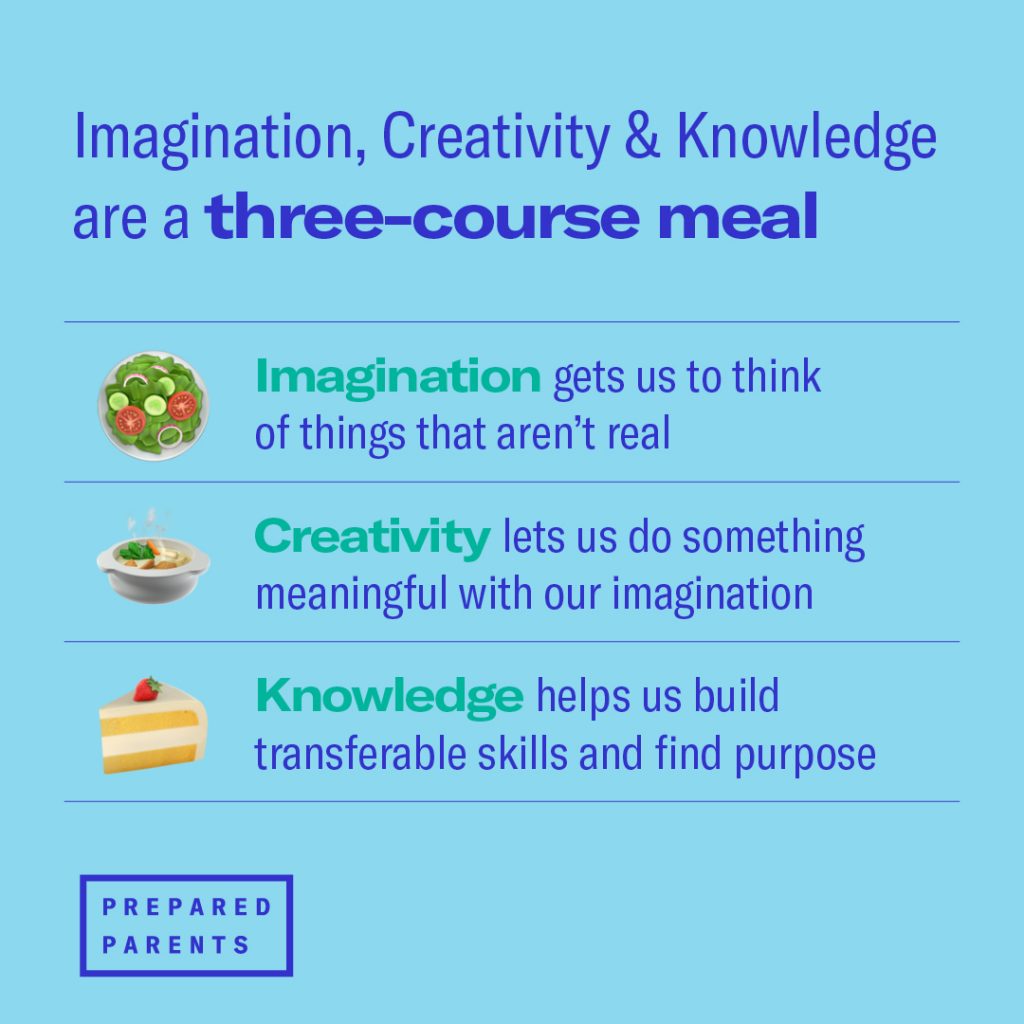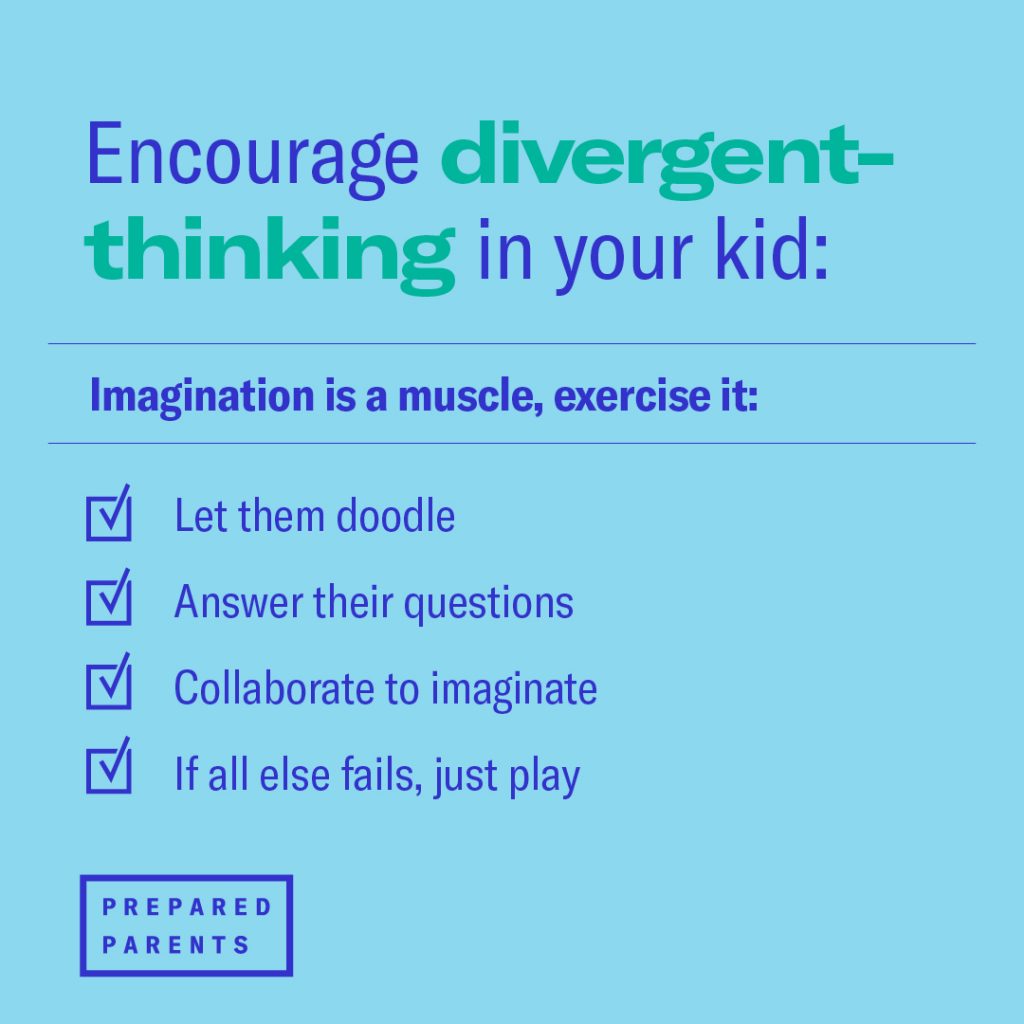
Imagination, creativity, and knowledge are like a three-course meal. They are not only mutually satisfying; they complement each other and that spurs us on to seek to continually enjoy them. It’s a virtuous cycle of learning. Each of these is distinctly different.
- Imagination, the first course, gets us to think of things that aren’t real;
- Creativity, the main course, allows us to do something meaningful with our imagination; and
- Knowledge, the dessert, not only enables us to build a set of transferable skills, it leads us to find purpose.
Bill Damon, author of The Path to Purpose, says, “Purpose gives you a long-term compass that keeps you on track. It’s associated with lots of benefits, ranging from health to energy, to a sense that I’m satisfied with my life, and I’m finding fulfillment in my everyday actions.”
People who let their imagination reign drive and innovate solutions. We often call them outliers and mavericks, but these are the individuals our kids should try to emulate because the ability to imagine drives all creativity, enables clear thinking, and inspires a sense of humanity. It’s more than just adapting to the current situation. An imaginative approach can shape an environment into something very different, where we have the opportunity to thrive. In the classroom an active imagination improves students’ social and emotional skills, which empowers them to activate their curiosity.
The rapid rise in technology has advanced the business world at unprecedented speed. It took about one hundred years to move from the Industrial Age, when manufacturing was key to economic growth, into the Information Age that debuted in the late 20th century. The current Imagination Age is a period of transition that may be critical to preparing our kids for the future. LinkedIn’s Workplace Learning Report for 2020 confirms that computer technology skills are no longer as important for employment as a few years ago. Today it’s all about the skills for innovation.
The top five skills kids need most for future employment are:
- Creativity: generating original ideas and solutions
- Persuasion: convincing others to support your creativity
- Collaboration: working as a team to reach a common goal
- Adaptability: thriving in change and uncertainty
- Emotional intelligence: understanding and modulating your emotions and those of others.
The ability to tap into these skills will enable our kids to adapt to this rapidly changing environment. By the time they enter the workforce, we’ll be in the Intelligence Era.
A report from the McKinsey Global Institute predicts that by 2030 the demand for higher cognitive skills such as creativity, critical thinking and decision making, and complex information processing, will grow at cumulative double-digit rates.
Think of the imagination as a muscle that expands with frequent exercise. Even when kids are not focused on an external goal-oriented task, their minds are still working in what neuroscientist Marcus Raichle calls the “default mode network.” They’re tapping into memories, imagining future possibilities, replaying past interactions, and reflecting on who they are. Allow kids to get bored and daydream. That leads them to look inward and reflect. They’ll discover what interests and motivates them. The satisfaction they attain from what they’re doing will spur them on to deeper interests.
Here are some other ways to keep our kids imagining:
Let them doodle

One study found that “the effects of doodling on the academic and artistic learning of K-12 students… can increase focus and memory retention… relieve stress… and enhance creativity and imagination.” Drawing pictures or coloring also heightens intellectual arousal. Give your kid some paper, pencils or crayons and while you read or tell your kid a story, let them draw.
Answer their questions
Answering a kid’s question starts them on a path to imagine even deeper queries. How you respond can prompt deeper exploration that may take them in an unexpected direction. They’ll tap into their imagination to figure out how to learn more. Pediatrician Dr. Alan Greene says that when kids ask questions it may not be because they want an answer. It’s likely they want to engage with you in something that’s interesting to them. Dr. Greene explains, “What they really mean is, ‘That’s interesting to me. Let’s talk about that together. Tell me more, please?’”
Collaborate to imaginate.
If one kid can translate dreams into creativity, imagine what two or more can do! Kids who collaborate connect authentically with others as they work across differences to build a productive team. Learning to work well together elevates each team member’s contribution and improves a project’s outcome. Successful collaborators know their strengths and where they need to improve. They know what they contribute to their team because they know themselves: who they are, what they care about, what they know, and what they don’t know.
If all else fails, just play
Play involves testing out things with minimal risk. It’s typically self-directed and tends to use the imagination. Its value is in the activity, not in an end result, and it’s done solely for its own sake giving kids a chance to improvise, experiment, and make things up. The American Academy of Pediatrics now suggests that doctors prescribe some amount of solo play each day to spur inventive thinking.
Giving kids opportunities to flex their imagination muscle creates new opportunities for innovation and provides a path toward growth as they encounter countless possibilities.

